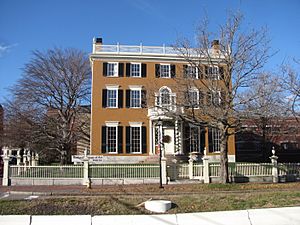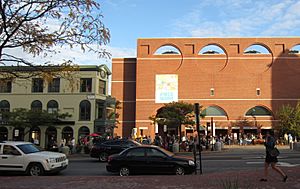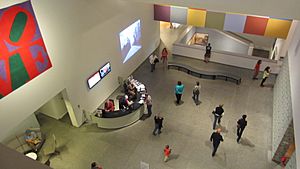Portland Museum of Art facts for kids

McLellan House, Portland Museum of Art
|
|
| Location | Portland, Maine |
|---|---|
| Type | Art Museum |
The Portland Museum of Art, or PMA, is the biggest and oldest public art museum in Maine. It started as the Portland Society of Art in 1882. You can find it in the downtown area of Portland, Maine, in a spot called The Arts District.
Museum History
The PMA used different places to show art until 1908. That year, a woman named Margaret Jane Mussey Sweat gave her large house, now called the McLellan House, to the museum. She also gave money to build a new art gallery. This gallery was built to remember her husband, Lorenzo De Medici Sweat, who was a U.S. Representative.
A famous architect from New England, John Calvin Stevens, designed the L. D. M. Sweat Memorial Galleries. These galleries opened to the public in 1911.
Museum Expansion
Over the next 65 years, the museum grew a lot. It needed more space for art, storage, and other important areas. In 1976, a man from Maine named Charles Shipman Payson promised to give the museum 17 paintings by the famous artist Winslow Homer.
Mr. Payson also gave $8 million to help build a new part of the museum. This new building was designed by Henry Nichols Cobb. Construction on the Charles Shipman Payson Building started in 1981. It opened to the public just two years later, in 1983.
Payson's gift of Homer paintings helped the museum grow even more. Many other important art collections were given to the museum. For example, in 1979, the Hamilton Easter Field Art Foundation Collection added over 50 paintings and sculptures by American modern artists.
In 1991, the Joan Whitney Payson Collection was given to the museum. This collection, from Charles Payson's wife Joan Whitney Payson, included 20 Impressionist and Post-Impressionist artworks. In 1996, Elizabeth B. Noyce, an art collector and helper in Maine, gave 66 American artworks to the museum. This was the biggest gift of American art the museum had ever received.
Today, about 140,000 people visit the PMA each year. The museum also has around 8,500 members.
Art Collection
The museum has a huge collection of over 22,000 artworks. These pieces date from the 1700s all the way to today. The PMA's collection includes art by famous artists like Winslow Homer, Marsden Hartley, John Marin, Louise Nevelson, Andrew Wyeth, and John Greenleaf Cloudman.
The museum also has the largest collection of European art in Maine. Important European art styles like Impressionism and Surrealism are shown. These come from the Joan Whitney Payson, Albert Otten, and Scott M. Black collections. You can see works by artists such as Mary Cassatt, Edgar Degas, René Magritte, Claude Monet, Edvard Munch, Pablo Picasso, and Auguste Rodin.
The Elizabeth B. Noyce Collection includes 66 paintings and sculptures. Among these are works by George Bellows, Alfred Thompson Bricher, Abraham Walkowitz, and Jamie Wyeth. There are also masterpieces by Childe Hassam, Fitz Henry Lane, and N. C. Wyeth.
Museum Buildings
The museum is made up of three important buildings. These buildings show the history of American art and culture over three centuries.
Since it opened in 1983, the Charles Shipman Payson Building has been the main entrance for visitors. The museum always wanted to connect all three buildings: the Payson Building, the L. D. M. Sweat Memorial Galleries, and the McLellan House. In 2000, the museum started a project to raise money for this goal.
The project to connect the three buildings began in late 2000 and finished in October 2002. The McLellan House and L. D. M. Sweat Memorial Galleries now focus on 19th-century American art. The Payson Building holds European and American art from the 20th and 21st centuries.
This project made the McLellan House look like its original beautiful style. It also brought back the grand look of the L. D. M. Sweat Memorial Galleries. This created special spaces for the museum's great collection of 19th-century American art. The museum's larger space allows it to show more of its permanent collection. This collection has grown in quality and importance over the years.
In 2014, architects were hired to plan for the museum's future growth. The museum is open from 10:00 a.m. to 6:00 p.m. every day except Monday and Tuesday.
142 Free Street Building
The building at 142 Free Street was built in 1830 as a theater. It was a church for 85 years before the Portland Chamber of Commerce bought it in 1926. John Calvin Stevens renovated it then. Later, it became the Children's Museum of Maine.
In 2009, the Congress Street Historic District was created. The building at 142 Free Street was listed as an important building in this historic area. The Portland Museum of Art bought the building in 2019.
In 2022, the museum shared plans for a large expansion. This plan would involve tearing down the historic former Children's Museum of Maine building at 142 Free Street. Several international architecture firms created designs, and LEVER created the winning design in 2022.
In 2023, the Portland Museum of Art asked for the building to be removed from the historic district list. The museum director, Mark Bessire, said the building lacked "historical stature." Some people disagreed with this idea. A history professor called the argument "cynical." Other people, including a former museum director, also spoke against the plan.
The owner of the Time and Temperature Building worried that changing the historic status of 142 Free Street could affect tax credits for other historic buildings. Both the Portland Planning Board and the Historic Preservation Board voted against removing the building's historic status.
However, in May 2024, the Portland City Council voted 6-3 to remove the building's historic classification. In June 2024, a group called Greater Portland Landmarks sued to stop the City Council's decision. In March 2025, a judge ruled that the reclassification stands, meaning the demolition can move forward.



